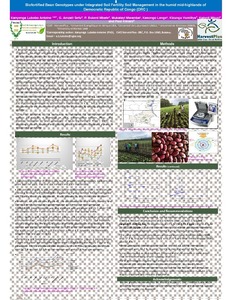Biofortified Bean Genotypes under Integrated Soil Fertility Soil Management in the humid mid-highlands of Democratic Republic of Congo (DRC)
Bean (Phaseolus vulgaris L) is an important crop for more than 20 millions people in Eastern, Southern and Western D.R. Congo, where its consumption can supply 60 % of dietary protein for rural and urban people with an estimated consumption of 60 kg per year and per person. It is the most grown legume that provides daily metabolic needs, on carbohydrates, proteins, and micronutrient.
•Despite high bean consumption , the malnutrition in general and malnutrition due to iron and zinc deficiency remains high and almost chronic within bean production areas and the prevalence of anemia due to iron deficiency is very high (53 % among pregnant women in North and South Kivu).
•Bean production level depends on many factors: yield potential, biotic and abiotic constraints and farming practices. Yield is always the first trait for famers and evidence for bio fortification breeding shows that high micronutrient concentration can be combined with yield, pests and diseases resistance.
•Although identification of best genotypes (through plant breeding), Understanding of trait expression to the optimal levels requires exploring environmental conditions and elucidating genotype‐by‐environment interactions (G x E). Soil is one of most components of the environment which can be influenced by farming practices such as ISFM.
• The main objective of this study was to investigate the contribution of ISFM options (in addition to breeding) on yield, micronutrient content, Pests and diseases resistance of bean genotypes in Multi‐Environment Trials ( MET), by assessing cultivar’s response and stability across environment (locations x years) in relationship with ISFM.

